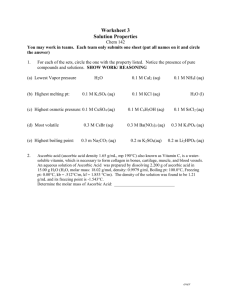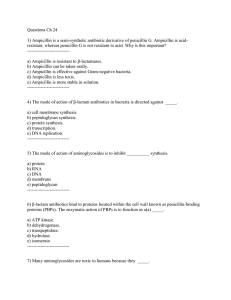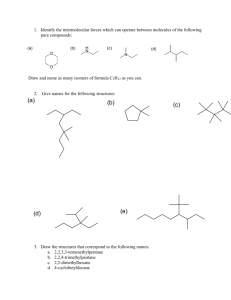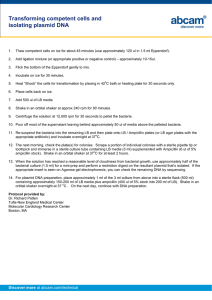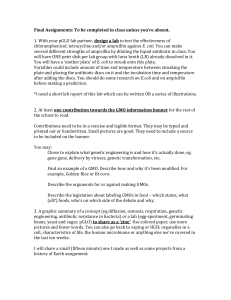Document 13309113
advertisement
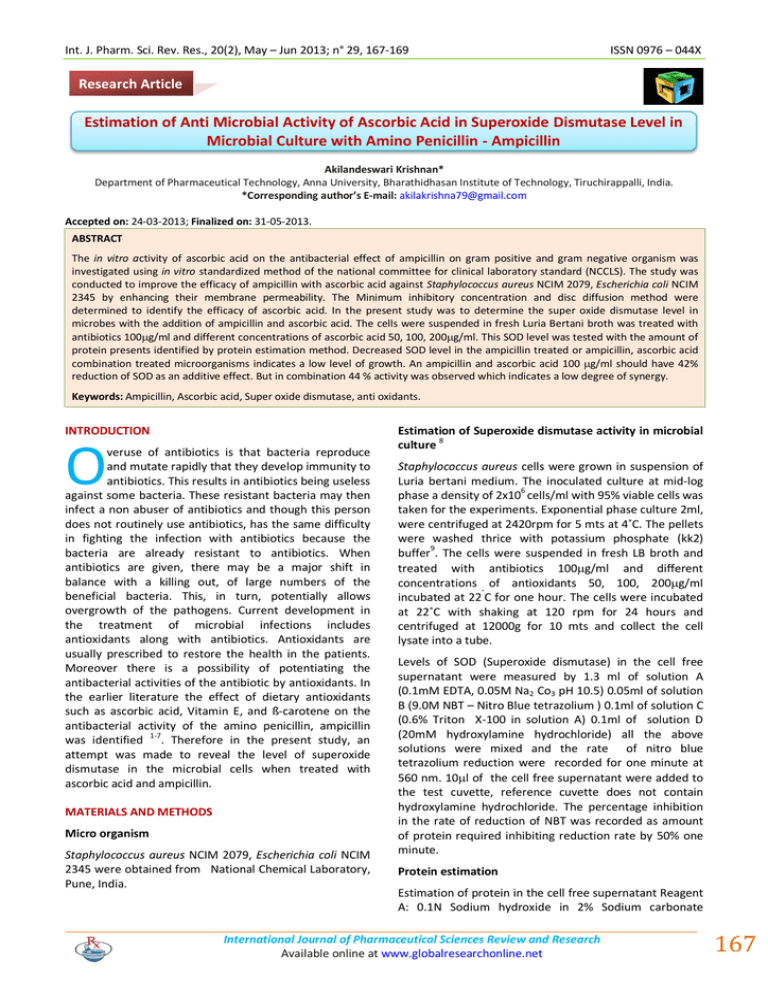
Int. J. Pharm. Sci. Rev. Res., 20(2), May – Jun 2013; n° 29, 167-169 ISSN 0976 – 044X Research Article Estimation of Anti Microbial Activity of Ascorbic Acid in Superoxide Dismutase Level in Microbial Culture with Amino Penicillin - Ampicillin Akilandeswari Krishnan* Department of Pharmaceutical Technology, Anna University, Bharathidhasan Institute of Technology, Tiruchirappalli, India. *Corresponding author’s E-mail: akilakrishna79@gmail.com Accepted on: 24-03-2013; Finalized on: 31-05-2013. ABSTRACT The in vitro activity of ascorbic acid on the antibacterial effect of ampicillin on gram positive and gram negative organism was investigated using in vitro standardized method of the national committee for clinical laboratory standard (NCCLS). The study was conducted to improve the efficacy of ampicillin with ascorbic acid against Staphylococcus aureus NCIM 2079, Escherichia coli NCIM 2345 by enhancing their membrane permeability. The Minimum inhibitory concentration and disc diffusion method were determined to identify the efficacy of ascorbic acid. In the present study was to determine the super oxide dismutase level in microbes with the addition of ampicillin and ascorbic acid. The cells were suspended in fresh Luria Bertani broth was treated with antibiotics 100g/ml and different concentrations of ascorbic acid 50, 100, 200g/ml. This SOD level was tested with the amount of protein presents identified by protein estimation method. Decreased SOD level in the ampicillin treated or ampicillin, ascorbic acid combination treated microorganisms indicates a low level of growth. An ampicillin and ascorbic acid 100 g/ml should have 42% reduction of SOD as an additive effect. But in combination 44 % activity was observed which indicates a low degree of synergy. Keywords: Ampicillin, Ascorbic acid, Super oxide dismutase, anti oxidants. INTRODUCTION O veruse of antibiotics is that bacteria reproduce and mutate rapidly that they develop immunity to antibiotics. This results in antibiotics being useless against some bacteria. These resistant bacteria may then infect a non abuser of antibiotics and though this person does not routinely use antibiotics, has the same difficulty in fighting the infection with antibiotics because the bacteria are already resistant to antibiotics. When antibiotics are given, there may be a major shift in balance with a killing out, of large numbers of the beneficial bacteria. This, in turn, potentially allows overgrowth of the pathogens. Current development in the treatment of microbial infections includes antioxidants along with antibiotics. Antioxidants are usually prescribed to restore the health in the patients. Moreover there is a possibility of potentiating the antibacterial activities of the antibiotic by antioxidants. In the earlier literature the effect of dietary antioxidants such as ascorbic acid, Vitamin E, and ß-carotene on the antibacterial activity of the amino penicillin, ampicillin was identified 1-7. Therefore in the present study, an attempt was made to reveal the level of superoxide dismutase in the microbial cells when treated with ascorbic acid and ampicillin. MATERIALS AND METHODS Micro organism Staphylococcus aureus NCIM 2079, Escherichia coli NCIM 2345 were obtained from National Chemical Laboratory, Pune, India. Estimation of Superoxide dismutase activity in microbial culture 8 Staphylococcus aureus cells were grown in suspension of Luria bertani medium. The inoculated culture at mid-log phase a density of 2x106 cells/ml with 95% viable cells was taken for the experiments. Exponential phase culture 2ml, were centrifuged at 2420rpm for 5 mts at 4˚C. The pellets were washed thrice with potassium phosphate (kk2) buffer9. The cells were suspended in fresh LB broth and treated with antibiotics 100g/ml and different concentrations of antioxidants 50, 100, 200g/ml incubated at 22˚C for one hour. The cells were incubated at 22˚C with shaking at 120 rpm for 24 hours and centrifuged at 12000g for 10 mts and collect the cell lysate into a tube. Levels of SOD (Superoxide dismutase) in the cell free supernatant were measured by 1.3 ml of solution A (0.1mM EDTA, 0.05M Na2 Co3 pH 10.5) 0.05ml of solution B (9.0M NBT – Nitro Blue tetrazolium ) 0.1ml of solution C (0.6% Triton X-100 in solution A) 0.1ml of solution D (20mM hydroxylamine hydrochloride) all the above solutions were mixed and the rate of nitro blue tetrazolium reduction were recorded for one minute at 560 nm. 10l of the cell free supernatant were added to the test cuvette, reference cuvette does not contain hydroxylamine hydrochloride. The percentage inhibition in the rate of reduction of NBT was recorded as amount of protein required inhibiting reduction rate by 50% one minute. Protein estimation Estimation of protein in the cell free supernatant Reagent A: 0.1N Sodium hydroxide in 2% Sodium carbonate International Journal of Pharmaceutical Sciences Review and Research Available online at www.globalresearchonline.net 167 Int. J. Pharm. Sci. Rev. Res., 20(2), May – Jun 2013; n° 29, 167-169 ISSN 0976 – 044X Reagent B: 1% Sodium potassium tartrate. (1gm in 100ml distilled water) Reagent C: 0.5% Copper sulphate in 1% sodium potassium tartrate. Reagent D: 48ml of reagent A +1ml of reagent B+1ml of reagent C. Reagent E Folin ciocaltue reagent (1:1) 10l of the sample and standard solution were taken for analysis. To this addition of 2ml of reagent D containing solution of A, B and C and waiting for 10 minutes as the reaction time. Following the reaction time addition of 0.1ml Folin ciocaltue reagent and waiting for 30 minutes. Then made up to 10ml with distilled water and reading were measured by spectrophotometer at 600 nm10. Table 1: Effect of Ascorbic acid Staphylococcus aureus by tube assay method. antibacterial on activity of ampicillin against Percentage Inhibition Ampicillin (g) Ampicillin Without Ascorbic acid Ascorbic acid 15 g Ascorbic acid 30 g Ascorbic acid 50 g Ascorbic acid 100g 2g 23.60 + 2.64 56.65 + 2.05 56.65 + 1.89* 57.08 + 1.55* 58.31 + 1.75* 4g 73.3 + 1.944 75.32 + 2.11 77.47 + 2.12* 78.68 + 1.52* 79.61 + 1.55* 8g 80.83 + 1.72 81.69 + 1.36 81.74 + 1.57 82.89 + 1.49 82.97 + 1.58 10g 81.9 + 0.70 82.08 + 1.8 81.82 + 1.26 83.99 + 1.63 83.83 + 1.58 15g 86.05 + 1.71 87.56 + 1.41 87.55 + 1.62 90.41 + 1.62* 91.7 + 2.3* * Values are compared with ampicillin significant at P<0.05; Superscript * indicate statistical significance when the values are compared with that of ampicillin alone at the same concentration at P<0.05. Table 2: Effects of ampicillin alone and combined ampicillin and ascorbic acid activity estimated by superoxide dismutase in the cell free supernatant against Staphylococcus aureus Sl. No. 1. 2. 3. 4. 5. 6. 7. Treatment group Control Ampicillin 100g Ampicillin 100g with Ascorbic acid 50g Ampicillin 100g with Ascorbic acid 100g Ampicillin 100g with Ascorbic acid 200g Ascorbic acid 100g Ascorbic acid 200g SOD U/mg of protein 183.33 + 6.48 135.54 + 7.0678* 111.11 + 8.9223* 103.17 + 7.8335* 88.88 + 9.0684* 153.88 + 7.5358 125.71 + 7.5408 Percentage reduction in SOD levels 26 % 39% 44% 51.99% 16% 31% * Values are compared with ampicillin significant at P<0.05; Superscript * indicate statistical significance when the values are compared with that of ampicillin alone at the same concentration at P<0.05. RESULTS AND DISCUSSION Percentage inhibition Ampicillin, oral amino penicillin is effective against gram 11 positive and gram negative organisms . Hence in the present study a gram positive microorganism Staphylococcus aureus and a gram negative microorganism Escherichia coli were chosen to assess the interaction between ampicillin and ascorbic acid. Moreover the selection of these two organisms can be justified on the basis that both the organisms may 12 develop resistance to the antibiotic . So the additive or synergistic effect of the ascorbic acid if any will be useful therapeutically in ampicillin resistant infections. The susceptibility of different microorganisms to antibiotics and antibiotic sensitivity of the organisms can be determined by various antimicrobial assays. Serial dilution method, tube assay method and cylinder plate method were the in vitro tests performed in the earlier study. = In tube assay method, the percentage inhibition was determined form the following formula: absorbance of positive control(without ampicillin) - absorbance of test solution 100 absorbance of positive control The percentage inhibition of the growth of Staphylococcus aureus at various concentrations of ampicillin with ascorbic acid was determined at very low concentration. The growth inhibition of Staphylococcus aureus by 2µg/ml level of ampicillin was rapidly increased even with a small amount of ascorbic acid in combination but further increase in ascorbic acid concentration did not have a proportionate enhancement of antibacterial activity shown in table 1. To elucidate Ascorbic acid shows synergy with ampicillin against Staphylococcus aureus. The reason may be the prevention of penicillinase activity of Staphylococcus aureus by ascorbic acid as it is already reported that Enterobacter cloacae ATCC 13047 showed increasing susceptibility to ampicillin when incubated anerobically in the presence of increasing concentrations of ascorbic acid through inhibition of -lactamase. Another molecule International Journal of Pharmaceutical Sciences Review and Research Available online at www.globalresearchonline.net 168 Int. J. Pharm. Sci. Rev. Res., 20(2), May – Jun 2013; n° 29, 167-169 found in literature, with which -lactamase have improved antibacterial activity is epigallocatechin gallate13-18. The synergy was contributed to the interference of epigallocatechin gallate with the integrative and biosynthesis of the bacterial cell wall through direct binding to peptidoglycan and inhibition of penicillinase activity. The antioxidant enzyme superoxide dimutase levels in the microbes were determined by kono et al method. Decreased SOD levels in the ampicillin treated or ampicillin, ascorbic acid combination treated microorganisms indicate a low level of growth. A combination of ampicillin and ascorbic acid 100 should have 42% reduction of SOD as an additive effect shown in table 2. But 44 % activity was observed which indicates a low degree of synergy. Soluble Bismuth Products Active against clostridium difficile. Antimicrob Agents Chemother, 49(1), 2005, 431-433. 6. Olson JA, Loveridge N, Duthie GG, Shearer MJ. Fat soluble th vitamins 13 CP. D.I.Thurnham DA.Bender J.Scott CG.Halsted. th Water soluble vitamins 14 CP. In J.S.Garrow, WPT James A th Kalph. Human nutrition and diatetics, 10 edition. Churchill Livingstone; 2002, 226-257. 7. Sobala GM, Schorah CJ, Shires S, Lynch DA, Gallacher B, Dixon MF, Axon AT. Effect of eradication of Helicobacter pylori on gastric juice ascorbic acid concentrations. Gut, 4(8), 1993, 103841. 8. Yasuhisa Kono. Generation of superoxide radical during auto oxidation of hydroxylamine and an assay for superoxide dismutase. Archives of Biochemistry and Biophysics, 186, 1978, 189-195. 9. Bandhana Katoch and Rasheedunnisa Begum. Biochemical basis of the high resistance to oxidative stress in Dictyostelium discoideum. J.Biosel, September 2003, 581-588. 10. Dubey RC, Maheswari DK, Practical microbiology S Chand & Company; 2002, 316-317. 11. Miles RS, Amyes SGB. Laboratory control of antimicrobial therapy. D.Baird. Staphylococcus: cluster forming gram positive cocci. In J.S.Collee, AG Frazer, BP Marmian, A.Simons, Mackie and th Mccartney. Practical medical microbiology 14 edition. Churchill Livingstone; 245-256, 151-200. 12. Satoskar RS, Bhandarkar SP, Ainapure SS. Pharmacology and th pharmacotherapeutics. Revised 16 edition, Popular Pakashan Penicillins and antibiotics effective mainly against gram positive organisms, 1999, 638-639. 13. Wei-Hua Zhao, Zhi-Quing Hu, Yukihiko Hara, and Tadakatsu Shinamura. Inhibition of Penicillinase by Epigallocatechin Gallate Resulting in Restoration of Antibacterial Activity of Penicillin against Penicillinase-Producing Staphylococcus aureus. Antimicrob Agents Chemother, 46(7), 2002, 2266-2268. 14. Wei-Hua Zhao, Zhi-Quing Hu, Yukihiko Hara, and Tadakatsu Shinamura. Mechanism of Synergy between Epigallocatechin Gallate and -Lactams against Methicillin-Resistant Staphylococcus aureus. Antimicrob Agents Chemother, 45(6), 2001. CONCLUSION To elucidate the interaction between ampicillin sodium and ascorbic acid, with different concentrations was used and estimate the results. The growth inhibition of Staphylococcus aureus by 2µg/ml level of ampicillin was rapidly increased even with a small amount of ascorbic acid in combination but further increase in ascorbic acid concentration did not have a proportionate enhancement of antibacterial activities. The super oxide dismutase level was tested with the combination which exhibits a additive, synergic effect. From our study we found out that the ascorbic acid was a better antioxidant and it may be used in the treatment of infectious diseases with the antibiotics. Based on these studies smaller doses of ascorbic acid were shown to enhance the activity of ampicillin against many bacteria as well as reduce allergic reaction to antibiotics. Ascorbic acid also decreases the usage of antibiotics needed to kill bacteria. ISSN 0976 – 044X REFERENCES 1. Vijaya C, Akilandeswari K, Pratheesh A, Babu Thandapani A. An in vitro investigation study on the interaction between certain dietary anti-oxidants with ampicillin. The antiseptic, 104(12), 2007, 615-618. 15. Yanagawa Y, Yamamoto Y, Hara Y, Shimamura T. A combination effect of epigallocatechin gallate, a major compound of green tea catechins, with antibiotics on Helicobacter pylori growth in vitro. Curr Microbiol, 47(3), 2003, 244-9. 2. Labriola D, Livingston R. Possible interations between diatary antioxidants and chemotherapy. Oncology, 13, 1999, No 7. 16. 3. Kataev SV, Brodinova NS, Moroz AF. Search for antimicrobial agents and their various combinations that are effective in relation to the main microfloral representatives in the burn wound, Antibiotiki, 25(3), 1980, 188-93. Yam TS, Hamilton-Miller JMT and Saroj Shah. The effect of a component of tea (Camellia sinensis) on methicillin resistance, PBP2` synthesis, and -Lactamase production in Staphylococcus aureus. Journal of Antimicrobial Chemotherapy, 42, 1998, 211216. 17. De lencastre H, de Jonge BL, Matthews PR Tomasz A. Molecular aspects of methicillin resistance in Staphylococcus aureus. J Antimicrob Chemother, 33(1), 1994, 7-24. 18. Shoeb HA, Al-Shora HI, Abdel-Salam T. Ascorbate as an induction inhibitor of -lactamase in a strain of Enterobacter cloacae. Lett Appl. Microbiol, 21(6), 1995, 398-401. 4. Kruszewka H, Zareba T, Tvski S. Search of antimicrobial activity of selected non-antibiotic drugs. Acta Pol Pharm, 59(6), 2002, 436-9. 5. Mahony DE, Woods A, Eelman MD, Burford N, Veldhuyzen SJO, Van Zanten. Interaction of Bismuth Subsalicylate with fruit juices, Ascorbic Acid, and Thiol-Containing Substrates to Produce Source of Support: Nil, Conflict of Interest: None. International Journal of Pharmaceutical Sciences Review and Research Available online at www.globalresearchonline.net 169
